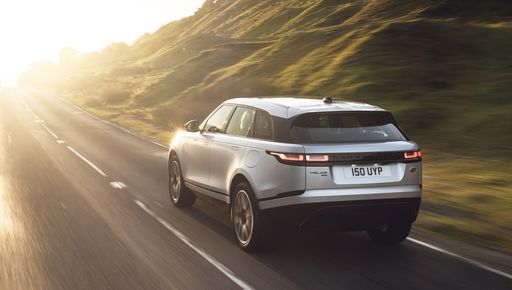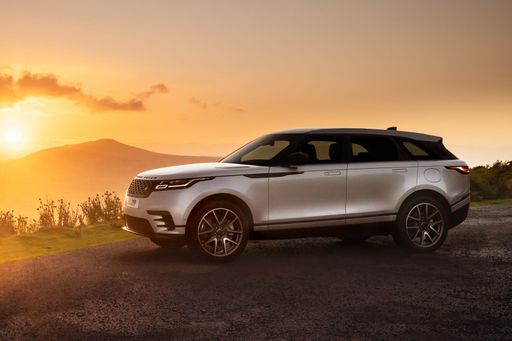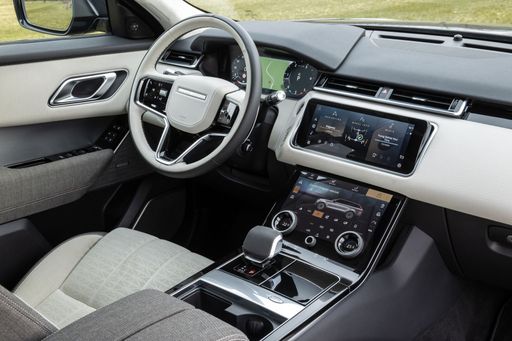Renault Trafic Bus VS Land Rover Range Rover Velar – Specs, Efficiency & Price Comparison
Which model is the better choice – the Renault Trafic Bus or the Land Rover Range Rover Velar? We compare performance (150 HP vs 404 HP), boot capacity ( vs 552 L), efficiency (6.80 L vs 1.90 L), and of course, the price (38200 £ vs 61900 £).
Find out now which car fits your needs better!
The Renault Trafic Bus (Bus) is powered by a Diesel engine and comes with a Manuel transmission. In comparison, the Land Rover Range Rover Velar (SUV) features a Diesel MHEV, Petrol MHEV or Plugin Hybrid engine and a Automatic gearbox.
When it comes to boot capacity, the Renault Trafic Bus offers , while the Land Rover Range Rover Velar provides 552 L – depending on what matters most to you. If you’re looking for more power, you’ll need to decide whether the 150 HP of the Renault Trafic Bus or the 404 HP of the Land Rover Range Rover Velar suits your needs better.
There are also differences in efficiency: 6.80 L vs 1.90 L. In terms of price, the Renault Trafic Bus starts at 38200 £, while the Land Rover Range Rover Velar is available from 61900 £.
Compare all the key specs now and find out which model fits your lifestyle best!
Renault Trafic Bus
The Renault Trafic Bus is a versatile and spacious option for those needing to transport multiple passengers comfortably. With its modern design and practical features, it is well-suited for both business and leisure purposes. Its efficient engine and smooth handling make it a reliable choice for long journeys.
detailsLand Rover Range Rover Velar
The Land Rover Range Rover Velar exemplifies a harmonious blend of elegance and capability, capturing the essence of modern luxury SUVs. Its sleek silhouette and refined design details make it stand out on both urban roads and off-road adventures. Inside, the Velar offers an impeccably crafted interior, combining premium materials with cutting-edge technology for a sophisticated driving experience.
details @ media.landrover.com
@ media.landrover.com
 @ media.landrover.com
@ media.landrover.com
 @ media.landrover.com
@ media.landrover.com
 @ media.landrover.com
@ media.landrover.com

|
|
|
|
|
Costs and Consumption |
|
|---|---|
|
Price
38200 - 51100 £
|
Price
61900 - 87400 £
|
|
Consumption L/100km
6.8 - 7.2 L
|
Consumption L/100km
1.9 - 10.2 L
|
|
Consumption kWh/100km
-
|
Consumption kWh/100km
-
|
|
Electric Range
-
|
Electric Range
61 km
|
|
Battery Capacity
-
|
Battery Capacity
15.40 kWh
|
|
co2
179 - 188 g/km
|
co2
43 - 232 g/km
|
|
Fuel tank capacity
80 L
|
Fuel tank capacity
62 - 83 L
|
Dimensions and Body |
|
|---|---|
|
Body Type
Bus
|
Body Type
SUV
|
|
Seats
8 - 9
|
Seats
5
|
|
Doors
4
|
Doors
5
|
|
Curb weight
2031 - 2321 kg
|
Curb weight
2003 - 2280 kg
|
|
Trunk capacity
-
|
Trunk capacity
503 - 552 L
|
|
Length
5080 - 5480 mm
|
Length
4797 mm
|
|
Width
1956 mm
|
Width
1933 mm
|
|
Height
1973 - 1974 mm
|
Height
1657 - 1665 mm
|
|
Payload
749 - 982 kg
|
Payload
460 - 587 kg
|
Engine and Performance |
|
|---|---|
|
Engine Type
Diesel
|
Engine Type
Diesel MHEV, Petrol MHEV, Plugin Hybrid
|
|
Transmission
Manuel
|
Transmission
Automatic
|
|
Transmission Detail
Schaltgetriebe
|
Transmission Detail
Automatikgetriebe
|
|
Drive Type
Front-Wheel Drive
|
Drive Type
All-Wheel Drive
|
|
Power HP
110 - 150 HP
|
Power HP
204 - 404 HP
|
|
Acceleration 0-100km/h
13.6 - 16.5 s
|
Acceleration 0-100km/h
5.4 - 8.3 s
|
|
Max Speed
161 - 174 km/h
|
Max Speed
209 - 250 km/h
|
|
Torque
300 - 350 Nm
|
Torque
430 - 650 Nm
|
|
Number of Cylinders
4
|
Number of Cylinders
4 - 6
|
|
Power kW
81 - 110 kW
|
Power kW
150 - 297 kW
|
|
Engine capacity
1997 cm3
|
Engine capacity
1997 - 2997 cm3
|
General |
|
|---|---|
|
Model Year
2023 - 2024
|
Model Year
2024
|
|
CO2 Efficiency Class
G
|
CO2 Efficiency Class
G, B
|
|
Brand
Renault
|
Brand
Land Rover
|
Renault Trafic Bus
A Glimpse into the Renault Trafic Bus: An Icon of Versatility and Innovation
Amongst the plethora of vans designed for both business and leisure, the Renault Trafic Bus stands out as an exemplar of functionality, innovation, and style. Let's delve into what makes the Renault Trafic Bus a popular choice in the UK and across Europe, particularly focusing on its technical specifications and state-of-the-art features.
Performance Dynamics: Power Under the Hood
The Renault Trafic Bus, a staple in Renault's fleet, is driven by a robust diesel engine configuration with power outputs ranging from 110 PS to a formidable 170 PS. The diesel engines combine efficiency and power, offering torque figures between 300 to 380 Nm, ensuring smooth power delivery and capable load hauling.
Drivers can choose between manual and automatic transmissions, both designed to complement the Trafic's front-wheel-drive system. This flexibility ensures that drivers experience enhanced driving comfort whether they are navigating urban roads or cruising on the motorway.
Efficiency Meets Economy
The Trafic Bus showcases impressive fuel economy with consumption figures ranging from 6.8 to 7.2 litres per 100 kilometres. This efficiency is crucial for businesses aiming to minimise operational costs and for families seeking budget-friendly travel options.
With a generous fuel tank capacity of 80 litres, the Renault Trafic Bus is built to cover long distances with fewer fuel stops, making it an ideal choice for long haul journeys.
Technological Innovations and Comfort
The Trafic Bus isn't just about robust performance. Renault has integrated a suite of technological innovations designed to enhance driver and passenger comfort. Its cabins are equipped with the latest infotainment systems and safety technologies, providing an optimal blend of comfort and convenience.
The various trims, such as Life, Start, Spaceclass, and their respective EDC variants, cater to different needs and preferences, ensuring that customers can find the perfect configuration for their requirements.
Design and Dimensions: Space for Every Purpose
Space and versatility are at the heart of the Trafic Bus design. With its dimensions ranging from a length of 5080 to 5480 mm, and a width of 1956 mm, this vehicle offers ample room for passengers and cargo alike. The height stands between 1973 and 1974 mm, ensuring that even taller individuals can travel comfortably.
With seating for up to eight people and a payload capacity between 730 to 1010 kg, the Trafic Bus can transform seamlessly between a people-mover and a goods carrier.
Environmental Considerations
Renault has engineered the Trafic Bus with environmental responsibility in mind. The CO2 emissions range from 178 to 190 g/km, which, while modest for its class, aligns with the efficiency and performance goals set for this versatile vehicle. The CO2 efficiency class is rated as 'G', offering transparency in its environmental impact profile.
Conclusion: A Leader in Its Class
The Renault Trafic Bus continues to lead its segment through a blend of power, efficiency, and technological advancements. Whether it's for commercial transport or family adventures, the Trafic offers a reliable and adaptable solution, setting a high standard for multi-purpose vehicles.
For those seeking a distinguished blend of utility and comfort, the Renault Trafic Bus emerges as an exceptional choice, promising performance and innovation on every journey.
Land Rover Range Rover Velar
Discovering the Avant-Garde: The Land Rover Range Rover Velar
The Land Rover Range Rover Velar is not just an SUV; it embodies the perfect blend of luxury, innovation, and engineering excellence. With a sleek design that seamlessly merges aesthetics with functionality, the Velar stands out as a pioneer in the world of modern vehicles, offering a driving experience that is not only comfortable but ingeniously intelligent.
Ingenious Engineering: Powertrains and Performance
The Velar offers a range of powertrains that cater to diverse driving preferences and environmental considerations. From Diesel Mild-Hybrids to Plug-In Hybrids, the Velar ensures that every journey is efficient and powerful. With a power output ranging from 204 to 404 PS and an impressive acceleration from 0 to 100 km/h in just 5.4 to 8.3 seconds, the Velar is a force to be reckoned with.
Every model comes with an advanced automatic transmission system that complements its sophisticated all-wheel-drive setup, ensuring enhanced grip and stability under various driving conditions. The meticulous engineering allows for a maximum speed ranging from 209 to 250 km/h, making it a true performer on any road.
Eco-Conscious Innovation
In an era where sustainability is key, the Velar stands out with its eco-friendly options. The P400e Plug-In Hybrid variant offers a remarkable CO2 efficiency, with figures as low as 43 g/km and a fuel consumption of just 1.9 L/100km. This model brings an electric range of 61 km, thanks to its state-of-the-art 15.4 kWh battery, perfect for daily commutes that are both economical and environmentally responsible.
Luxury Meets Technology: Interior and Features
Inside the Velar, luxury is complemented by cutting-edge technology. The cabin is designed to provide an immersive experience, with premium materials and advanced digital interfaces that streamline both information and entertainment. The standard five-seat configuration boasts a generous 552-litre boot capacity, perfect for both everyday tasks and adventurous escapades.
The Velar's interior is crafted to ensure comfort and sophistication, with a focus on ergonomic design and top-tier finishes. Its innovative infotainment system offers seamless connectivity, ensuring drivers and passengers stay entertained and informed wherever they go.
Design and Functionality: The Exterior
The design of the Velar is nothing short of a masterpiece. It exhibits a harmonious blend of elegance and modernity, characterised by clean lines and a confident stance. With dimensions measuring 4797 mm in length, 1933 mm in width, and a height ranging from 1657 to 1665 mm, the Velar is as commanding as it is stylish.
Attention to detail is evident in every aspect, from the striking LED headlights to the distinctive grille design that invites admiration at every turn. The Velar is more than capable of handling urban adventures and off-road escapades with equal aplomb, thanks to its robust build and thoughtfully designed amenities.
Conclusion: A Paradigm of Excellence
The Land Rover Range Rover Velar is a quintessential example of how modern engineering and design can elevate an SUV to extraordinary levels. Offering a harmonious blend of power, sustainability, and luxury, it sets a benchmark in its segment. For those seeking an SUV that delivers on all fronts—from technology and elegance to environmental responsibility—the Velar is an unbeatable choice, a testament to Land Rover's commitment to excellence.
The prices and data displayed are estimates based on German list prices and may vary by country. This information is not legally binding.
